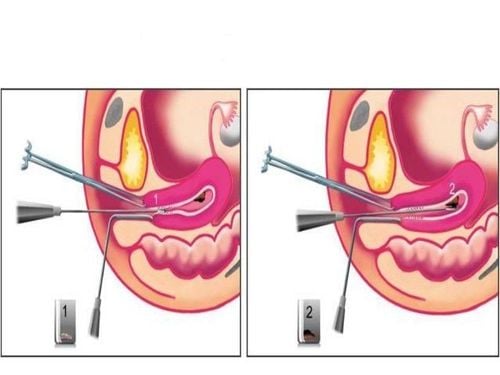This is an automatically translated article.
The article was professionally consulted by Specialist Doctor I Pham Thi Yen - Department of Obstetrics and Gynecology - Vinmec Hai Phong International General Hospital.Endometrial ablation is an important surgical procedure, with certain benefits and risks to a woman's health and fertility.
1. What is endometrial ablation?
Endometrial ablation is a procedure that destroys a thin layer of the lining of the uterus, helping to reduce or return to normal menstrual bleeding in women. Further treatment with other methods or surgery may be necessary if excision still fails to control heavy menstrual bleeding.2. Why is endometrial ablation needed?
Endometrial ablation is used to treat causes of heavy menstrual bleeding in women. In most cases, women with heavy bleeding will be treated with medication first. If the condition still cannot be controlled with medication, the doctor will recommend an endometrial ablation.
3. Circumstances in which endometrial ablation should not be performed
Endometrial ablation is not recommended for postmenopausal women and women with the following problems:Disorders of the uterus or endometrium Endometrial hyperplasia Uterine cancer Recently pregnant Newly infected or currently having a uterine infection
4. Is it possible to get pregnant after endometrial ablation?
The chance of getting pregnant after endometrial ablation is very low, but there are cases where it is possible to get pregnant. If there is a chance of pregnancy after endometrial ablation, the risk of miscarriage and other health problems increases greatly. If a woman wants to get pregnant, it is best not to have this procedure. Women who have had an endometrial ablation should use birth control until after menopause. In addition, sterilization methods can also be selected to prevent pregnancy after removal.Women after endometrial ablation still have full reproductive organs, so regular cervical cancer screening and gynecological examination are still essential.

5. What methods are used to perform endometrial ablation?
Here are the most common methods used to perform an endometrial ablation:Radiofrequency : a probe is inserted into the uterus through the cervix. From the top of the transducer, a reticular radio wave energy is emitted into the endothelium. The energy and heat destroy the endometrial tissue, which is then sucked out by the machine. Coagulation: a small probe is inserted into the uterus. The tip of the probe will cause the endometrium to clot. This technique is usually performed under ultrasound guidance. Hot fluids: fluids are put into the uterus through a hysteroscope - a small light-transmitting device that helps see the endometrium, then the fluid is heated and stays in the uterus. supply about 10 minutes. Thanks to the high temperature, the endothelium is easily destroyed. Hot water balloon: During hysteroscopy, the doctor places a balloon inside the uterus. Then, pump the balloon with hot liquid until the balloon expands and its edges are pressed against the endometrium. The endometrial layer will be destroyed at high temperature. Microwave energy: inserting a special probe into the uterus through the cervix, then transmitting microwave energy to the endometrium and destroying it. Electrosurgery: performed with a laparoscope - a small endoscopic device that is inserted into the uterine cavity. The tip of this scope can be a metal ring, a roller or a spike ball, they are charged to destroy the endometrium easily. This method is usually applied in the operating room and requires general anesthesia. However, it is not as commonly used as other methods. Common Symptoms After Surgery
Here are some common side effects after endometrial ablation:
Abdominal pain similar to menstrual cramps, usually lasting one to two days Yin The urethra is thin and mixed with blood. This can last a few weeks and is usually heavy in the first 2-3 days after surgery Frequent urination in the first 24 hours Nausea
6. Risks associated with endometrial ablation
Endometrial ablation can pose certain risks including the risk of infection and bleeding. Instruments used during surgery can cause perforation of the uterine wall or bowel. Some of the methods used are also capable of causing burns to the vagina and intestines.In rare cases, the fluids used to stretch the uterus during electrosurgery can be absorbed into the bloodstream and cause serious complications. To prevent this, carefully monitor the amount of fluid used during surgery.
Please dial HOTLINE for more information or register for an appointment HERE. Download MyVinmec app to make appointments faster and to manage your bookings easily.
Articles refer to the source Acog.org













